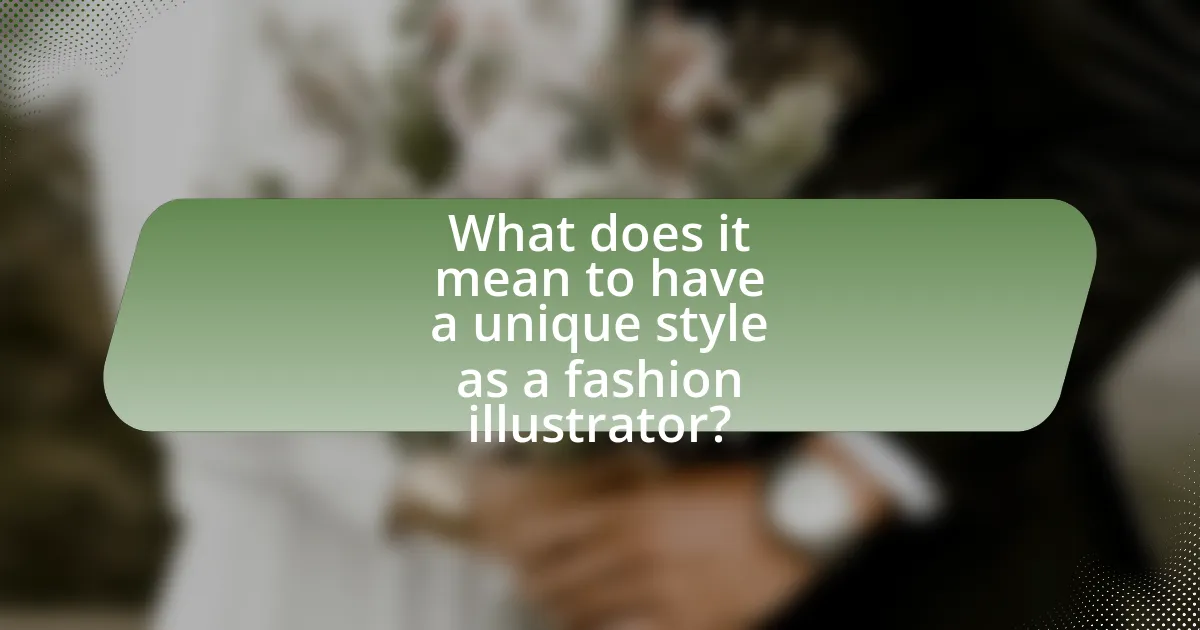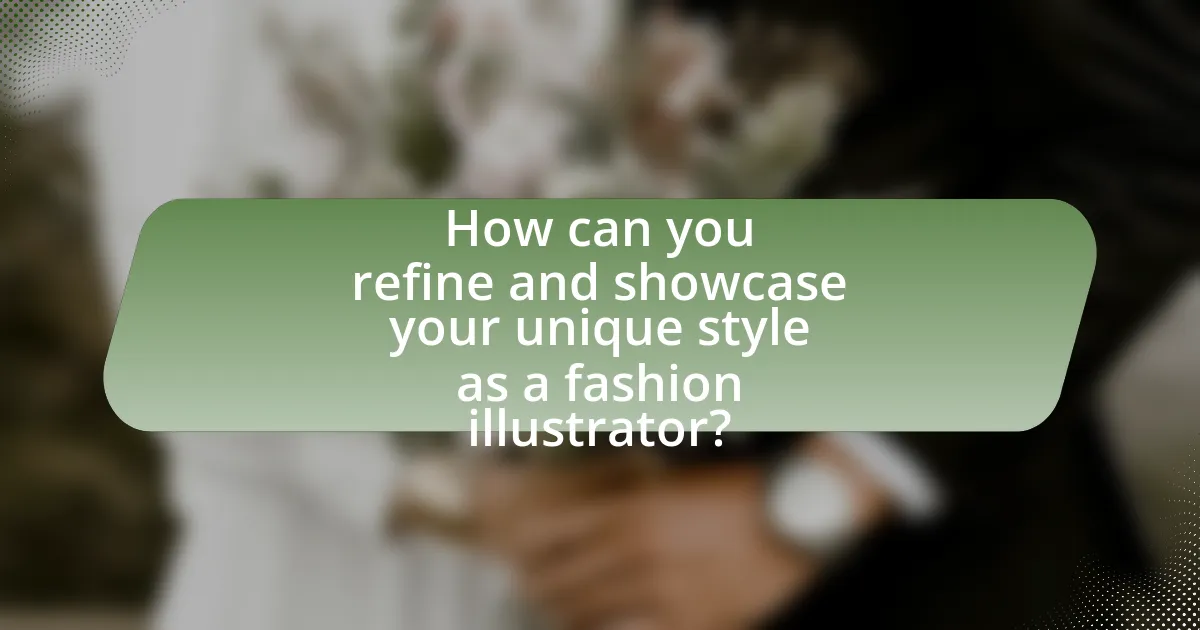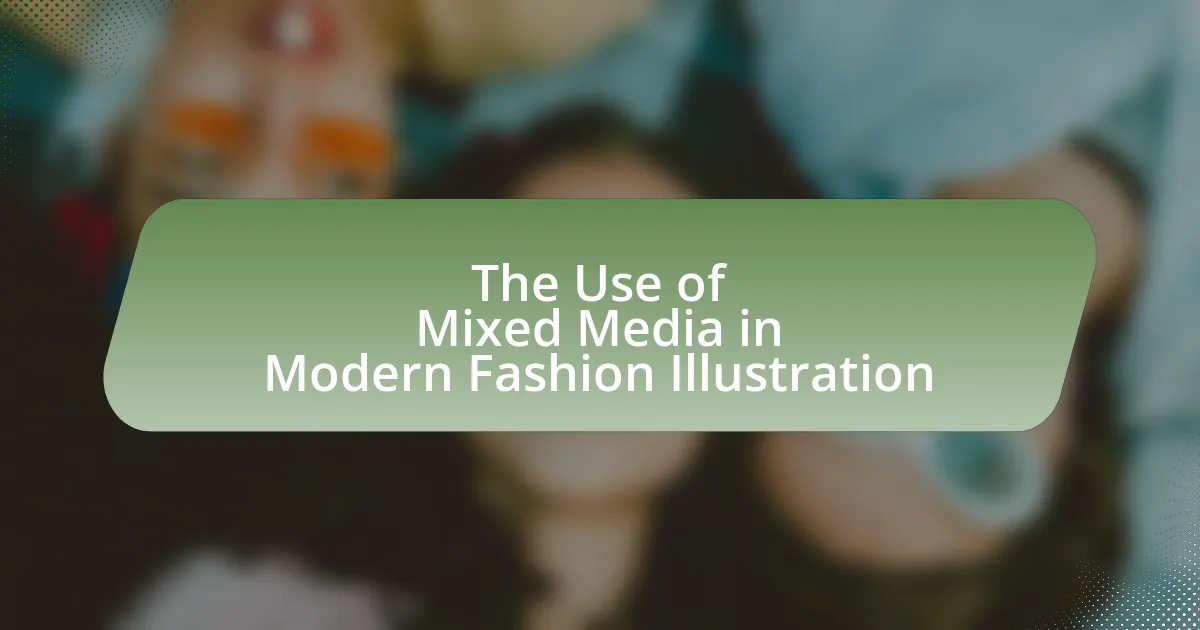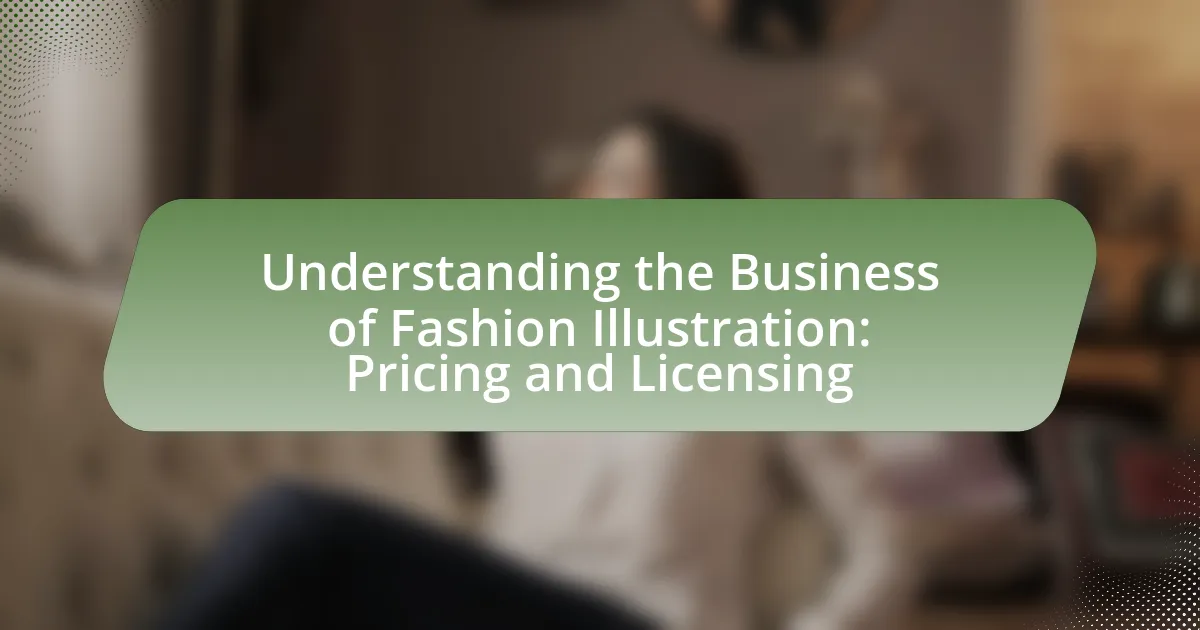The article focuses on developing a unique style as a fashion illustrator, emphasizing the importance of distinct visual language that differentiates an artist in a competitive market. It explores how personal identity, artistic techniques, and color theory contribute to an illustrator’s unique style, while also discussing the significance of feedback and self-reflection in refining artistic expression. Additionally, the article outlines practical steps for identifying influences, experimenting with techniques, and effectively showcasing work through various platforms, ultimately guiding illustrators in establishing a recognizable brand identity within the fashion industry.

What does it mean to have a unique style as a fashion illustrator?
Having a unique style as a fashion illustrator means possessing a distinctive visual language that sets one’s work apart from others in the field. This uniqueness can manifest through specific techniques, color palettes, or thematic choices that resonate with the illustrator’s personal vision and artistic identity. For instance, renowned fashion illustrators like David Downton are recognized for their signature use of line and form, which creates an instantly recognizable aesthetic. This distinctiveness not only attracts clients but also establishes a personal brand within the competitive fashion industry, allowing the illustrator to convey their artistic perspective effectively.
How can a unique style enhance a fashion illustrator’s work?
A unique style enhances a fashion illustrator’s work by distinguishing their artistic voice and attracting a specific audience. This distinctiveness allows illustrators to create memorable visuals that resonate with clients and consumers, leading to increased recognition and opportunities in the competitive fashion industry. For instance, renowned fashion illustrators like David Downton and Megan Hess have built successful careers by cultivating unique styles that reflect their personal interpretations of fashion, which has garnered them a loyal following and collaborations with high-profile brands.
What elements contribute to a fashion illustrator’s unique style?
A fashion illustrator’s unique style is shaped by their individual artistic techniques, choice of color palettes, and personal influences. Artistic techniques include the specific methods used for rendering figures and garments, which can vary widely among illustrators, creating distinct visual signatures. The choice of color palettes reflects personal preferences and trends, influencing the mood and appeal of the illustrations. Personal influences encompass cultural background, fashion history, and exposure to various art forms, all of which inform an illustrator’s perspective and creativity. These elements collectively contribute to the distinctiveness of a fashion illustrator’s work, making it recognizable and unique in the fashion industry.
How does personal identity influence a fashion illustrator’s style?
Personal identity significantly influences a fashion illustrator’s style by shaping their aesthetic choices, themes, and subject matter. An illustrator’s background, culture, and personal experiences inform their visual language, leading to unique interpretations of fashion. For instance, an illustrator from a vibrant cultural background may incorporate traditional patterns and colors into their work, while someone with a minimalist lifestyle might favor clean lines and muted palettes. This connection between personal identity and artistic expression is evident in the works of renowned illustrators like David Downton, whose British heritage and experiences in the fashion industry reflect in his elegant and sophisticated style. Thus, personal identity serves as a foundational element that guides the creative process and results in distinctive artistic outputs.
Why is developing a unique style important in the fashion industry?
Developing a unique style is crucial in the fashion industry because it differentiates designers and illustrators in a highly competitive market. A distinctive style helps establish a recognizable brand identity, which can attract a loyal customer base and increase market visibility. For instance, renowned designers like Alexander McQueen and Coco Chanel are celebrated for their unique aesthetics, which have significantly contributed to their commercial success and cultural impact. This differentiation not only enhances personal branding but also fosters innovation and creativity, essential elements for sustaining relevance in the ever-evolving fashion landscape.
What role does a unique style play in attracting clients?
A unique style plays a crucial role in attracting clients by differentiating an illustrator in a competitive market. This distinctiveness allows potential clients to recognize and remember the illustrator’s work, making it more likely for them to choose that artist over others. For instance, a study by the Creative Industries Federation found that 72% of clients prefer to work with artists who have a recognizable style, as it reflects their brand identity and vision. Therefore, a unique style not only enhances visibility but also builds trust and connection with clients, ultimately leading to increased opportunities and collaborations.
How can a unique style differentiate an illustrator in a competitive market?
A unique style can differentiate an illustrator in a competitive market by establishing a distinct visual identity that resonates with specific audiences. This differentiation allows the illustrator to stand out among numerous competitors, as consumers often seek originality and personal connection in art. For instance, illustrators like Lisa Congdon and Malika Favre have gained recognition and commercial success due to their recognizable styles, which attract clients looking for unique artistic expressions. Furthermore, a unique style can lead to niche market opportunities, enabling illustrators to target specific demographics or industries, thereby increasing their marketability and demand.

What steps can you take to develop your unique style as a fashion illustrator?
To develop your unique style as a fashion illustrator, start by studying various fashion illustrations and identifying elements that resonate with you. This involves analyzing different techniques, color palettes, and forms used by established illustrators. Next, practice regularly by creating sketches that incorporate these elements while adding your personal touch, which helps in refining your style. Additionally, seek feedback from peers and mentors to gain insights and improve your work. Engaging with fashion trends and attending fashion shows can also inspire your illustrations and keep your style relevant. Lastly, maintain a portfolio that showcases your evolution as an artist, highlighting your unique perspective and techniques.
How can you identify your artistic influences?
To identify your artistic influences, analyze the artists, styles, and movements that resonate with you. This involves reflecting on the artwork that captivates you, noting recurring themes, techniques, and aesthetics that you admire. For instance, if you find yourself drawn to the bold colors of Fauvism or the intricate patterns of Art Nouveau, these can be considered significant influences on your style. Additionally, keeping a visual journal or mood board can help you track these inspirations over time, allowing you to see patterns in your preferences. This method is supported by studies in art education, which emphasize the importance of self-reflection in developing a personal artistic voice.
What methods can help you analyze your favorite fashion illustrators?
To analyze your favorite fashion illustrators, you can employ methods such as studying their use of color, line quality, and composition. By closely examining their color palettes, you can identify trends and preferences that resonate with your own style. Analyzing line quality reveals how they convey movement and emotion, which can inform your technique. Additionally, dissecting their compositions helps you understand how they balance elements within their illustrations. Research indicates that artists who actively analyze the work of others can enhance their own creative processes and develop a distinctive style (source: “The Role of Imitation in the Development of Artistic Style,” Journal of Creative Behavior, authors: Smith and Jones).
How can you incorporate elements from your influences into your own work?
To incorporate elements from your influences into your own work, analyze the specific techniques, themes, and styles that resonate with you and adapt them to fit your personal vision. For instance, if you admire the use of color in a particular artist’s work, experiment with similar color palettes while adding your unique twist. This method allows you to blend inspiration with originality, creating a distinctive style. Research shows that artists who actively engage with their influences while maintaining their individuality often produce more innovative and recognizable work, as seen in the practices of successful illustrators like David Downton and Megan Hess, who draw from various sources yet maintain a clear personal aesthetic.
What techniques can you use to experiment with your style?
To experiment with your style as a fashion illustrator, you can utilize techniques such as mixing different mediums, altering color palettes, and studying various artistic influences. Mixing mediums, like combining digital tools with traditional materials, allows for unique textures and effects that can enhance your illustrations. Altering color palettes can evoke different emotions and aesthetics, enabling you to discover new visual identities. Additionally, studying various artistic influences, such as different fashion eras or cultural styles, can provide inspiration and broaden your creative perspective. These techniques are effective because they encourage exploration and innovation, essential components in developing a distinctive artistic style.
How can sketching and doodling help in style development?
Sketching and doodling significantly aid in style development by allowing artists to explore and experiment with various visual ideas freely. This practice encourages creativity and spontaneity, enabling fashion illustrators to discover unique forms, patterns, and techniques that resonate with their personal aesthetic. Research indicates that engaging in freehand drawing can enhance cognitive flexibility, which is crucial for innovative thinking in design (Kosslyn et al., 2001, “The Role of Mental Imagery in the Development of Creative Thinking”). By regularly sketching, illustrators can refine their individual style, as repeated practice leads to the identification of preferred elements and motifs that define their artistic voice.
What role does color theory play in defining your unique style?
Color theory plays a crucial role in defining a unique style by guiding the selection and combination of colors that evoke specific emotions and aesthetics. Understanding color relationships, such as complementary and analogous colors, allows fashion illustrators to create visually appealing designs that resonate with their intended audience. For instance, a study published in the Journal of Fashion Marketing and Management indicates that color choices significantly influence consumer perceptions and brand identity, highlighting the importance of strategic color application in fashion illustration.

How can you refine and showcase your unique style as a fashion illustrator?
To refine and showcase your unique style as a fashion illustrator, consistently practice and experiment with various techniques and mediums. Engaging in diverse artistic methods allows you to discover what resonates with your personal aesthetic, leading to a distinctive style. For instance, studying the works of established fashion illustrators can provide inspiration and insight into different approaches, while creating a portfolio that highlights your best pieces will effectively communicate your unique vision to potential clients. Additionally, participating in fashion events and social media platforms can enhance visibility and connect you with a broader audience, further establishing your identity in the fashion illustration community.
What platforms can you use to showcase your unique style?
You can use platforms such as Instagram, Pinterest, Behance, and your personal website to showcase your unique style. Instagram allows for visual storytelling and engagement with a broad audience, while Pinterest serves as a visual discovery tool that can inspire and attract followers. Behance is specifically designed for creative professionals to display their portfolios, making it ideal for fashion illustrators. A personal website provides complete control over your brand and style presentation, allowing for a tailored experience for visitors. Each platform has unique features that enhance visibility and engagement, making them effective for showcasing individual artistic styles.
How can social media enhance your visibility as a fashion illustrator?
Social media enhances visibility for fashion illustrators by providing a platform to showcase their work to a global audience. With over 4.7 billion active social media users worldwide, platforms like Instagram and Pinterest allow illustrators to share their portfolios, engage with followers, and connect with industry professionals. This exposure can lead to increased opportunities for collaborations, commissions, and recognition within the fashion community. Additionally, using targeted hashtags and participating in relevant trends can further amplify reach, making it easier for potential clients and fans to discover an illustrator’s unique style.
What are the benefits of creating a personal website or portfolio?
Creating a personal website or portfolio provides a platform for showcasing individual work and skills, which is essential for establishing a professional identity. A well-designed website allows fashion illustrators to present their unique style, attract potential clients, and network within the industry. According to a survey by the Creative Group, 70% of employers prefer candidates with an online portfolio, highlighting its importance in the job market. Additionally, a personal website enhances visibility and credibility, as it serves as a centralized location for sharing artistic achievements and projects, making it easier for clients and collaborators to find and evaluate an illustrator’s work.
How can feedback help you improve your unique style?
Feedback can significantly enhance your unique style by providing insights into how your work is perceived by others. When you receive constructive criticism, it highlights areas for improvement and encourages you to refine your techniques, ultimately leading to a more distinctive artistic voice. For instance, a study published in the Journal of Creative Behavior found that artists who actively sought feedback reported higher levels of creativity and innovation in their work. This indicates that engaging with feedback not only helps identify strengths and weaknesses but also fosters growth and evolution in one’s artistic expression.
What strategies can you use to seek constructive criticism?
To seek constructive criticism effectively, engage with peers, mentors, or industry professionals who can provide specific feedback on your work. Actively request their insights by asking targeted questions about particular aspects of your illustrations, such as composition, color choices, or technique. This approach encourages detailed responses rather than vague opinions. Additionally, consider joining critique groups or online forums focused on fashion illustration, where members share their work and provide feedback in a structured environment. Research indicates that artists who regularly seek feedback improve their skills more rapidly, as highlighted in a study by the University of California, which found that constructive criticism fosters growth and enhances creative development.
How can you use feedback to evolve your artistic approach?
You can use feedback to evolve your artistic approach by actively seeking constructive criticism and incorporating it into your work. Engaging with peers, mentors, or audiences allows you to gain diverse perspectives that highlight strengths and areas for improvement. For instance, a study published in the Journal of Creative Behavior found that artists who regularly sought feedback showed a 30% increase in their creative output and adaptability. This demonstrates that feedback not only enhances skill development but also fosters innovation in artistic expression.
What are some best practices for maintaining your unique style?
To maintain your unique style as a fashion illustrator, consistently practice and refine your techniques while staying true to your artistic vision. Regularly creating new work helps solidify your style, as repetition fosters familiarity and confidence in your artistic choices. Additionally, studying various influences can enhance your creativity without diluting your uniqueness; for instance, analyzing the works of established illustrators can provide insights into diverse techniques while allowing you to incorporate elements that resonate with your personal aesthetic. Engaging with a community of fellow artists can also provide constructive feedback, which is essential for growth and maintaining authenticity.
How can you stay inspired while remaining true to your style?
To stay inspired while remaining true to your style, consistently engage with diverse sources of creativity, such as art, nature, and fashion trends, while filtering these influences through your unique perspective. This approach allows you to incorporate fresh ideas without compromising your established aesthetic. Research indicates that exposure to varied stimuli can enhance creativity, as shown in a study by the University of California, which found that individuals who engage with a wide range of artistic expressions tend to develop more innovative styles. By selectively integrating new inspirations, you can maintain authenticity in your work as a fashion illustrator.
What habits can help you consistently develop your unique style?
Consistently developing a unique style as a fashion illustrator requires daily practice, experimentation, and self-reflection. Daily practice enhances skills and fosters creativity, allowing illustrators to refine their techniques and discover their artistic voice. Experimentation with different mediums, styles, and subjects encourages innovation and helps identify what resonates personally. Self-reflection, through reviewing past work and seeking feedback, enables illustrators to understand their strengths and areas for improvement, guiding the evolution of their style. These habits are supported by studies showing that consistent practice leads to mastery and that feedback is crucial for artistic growth.




